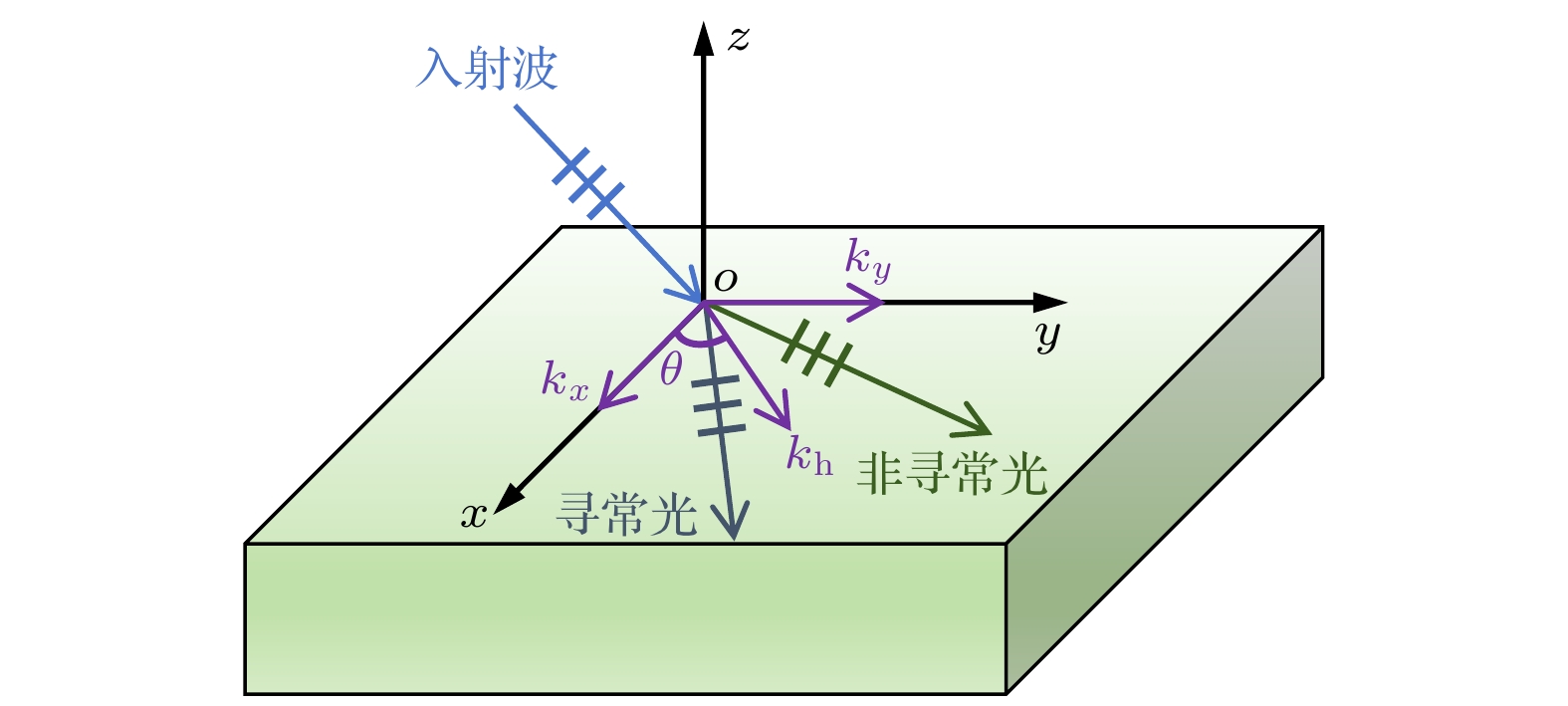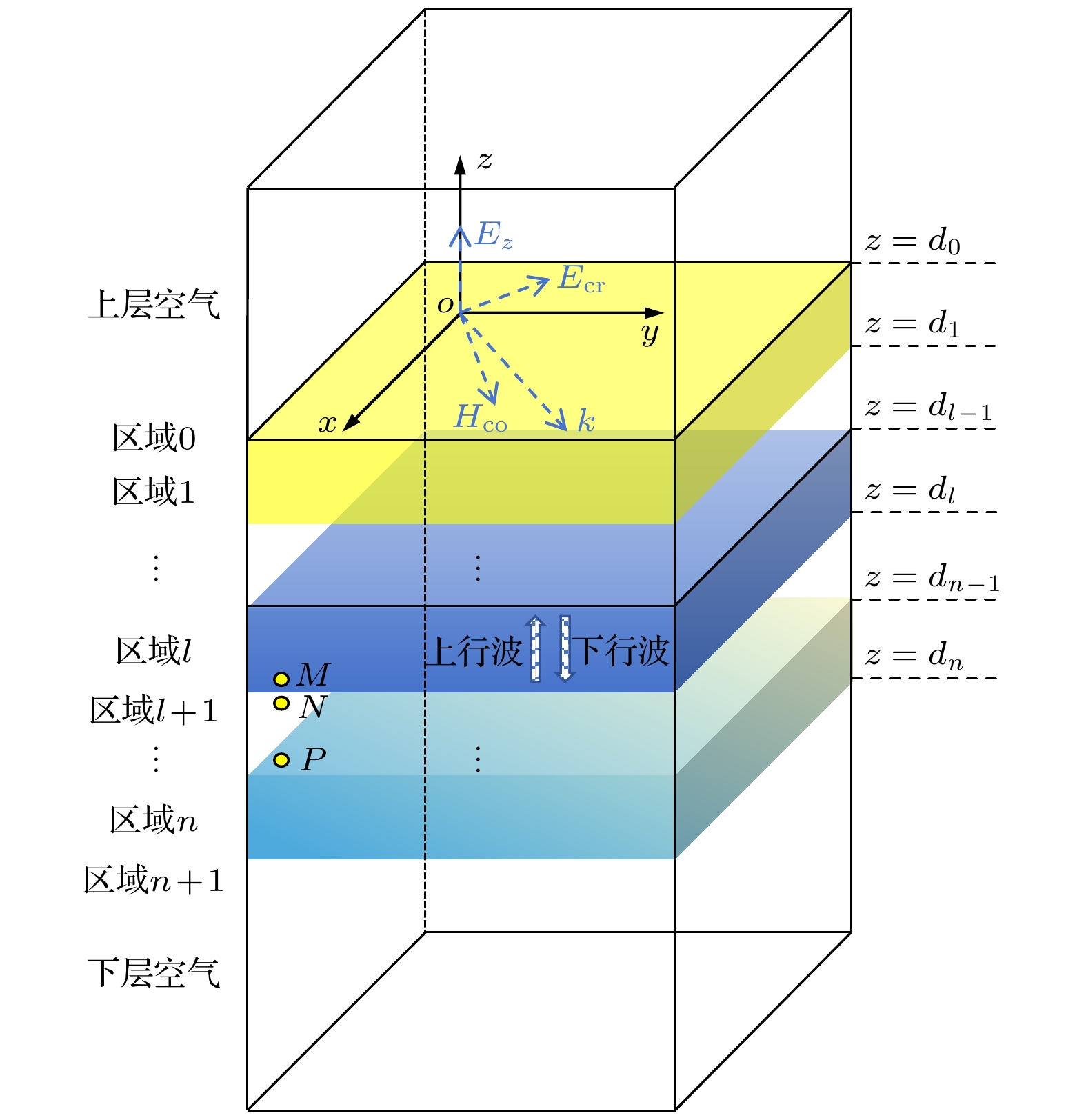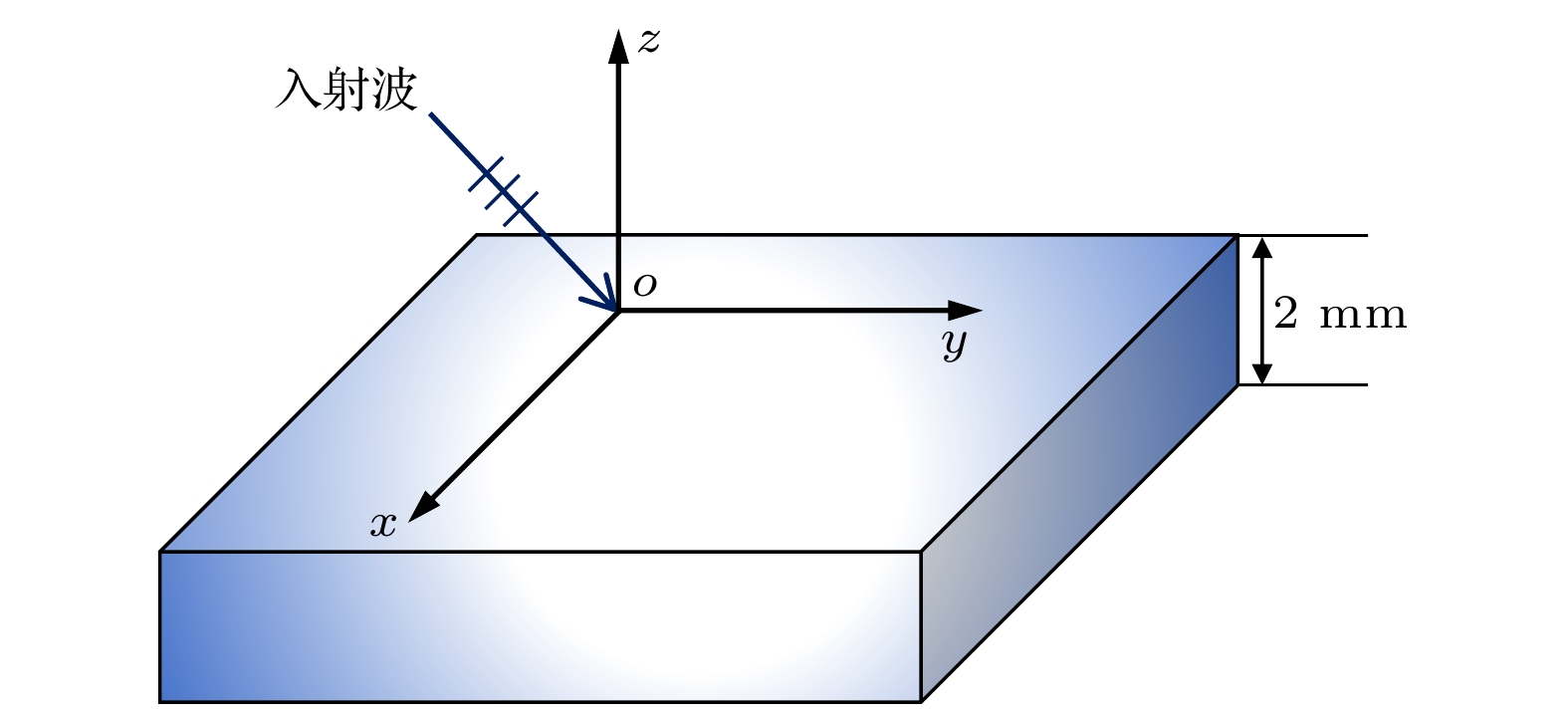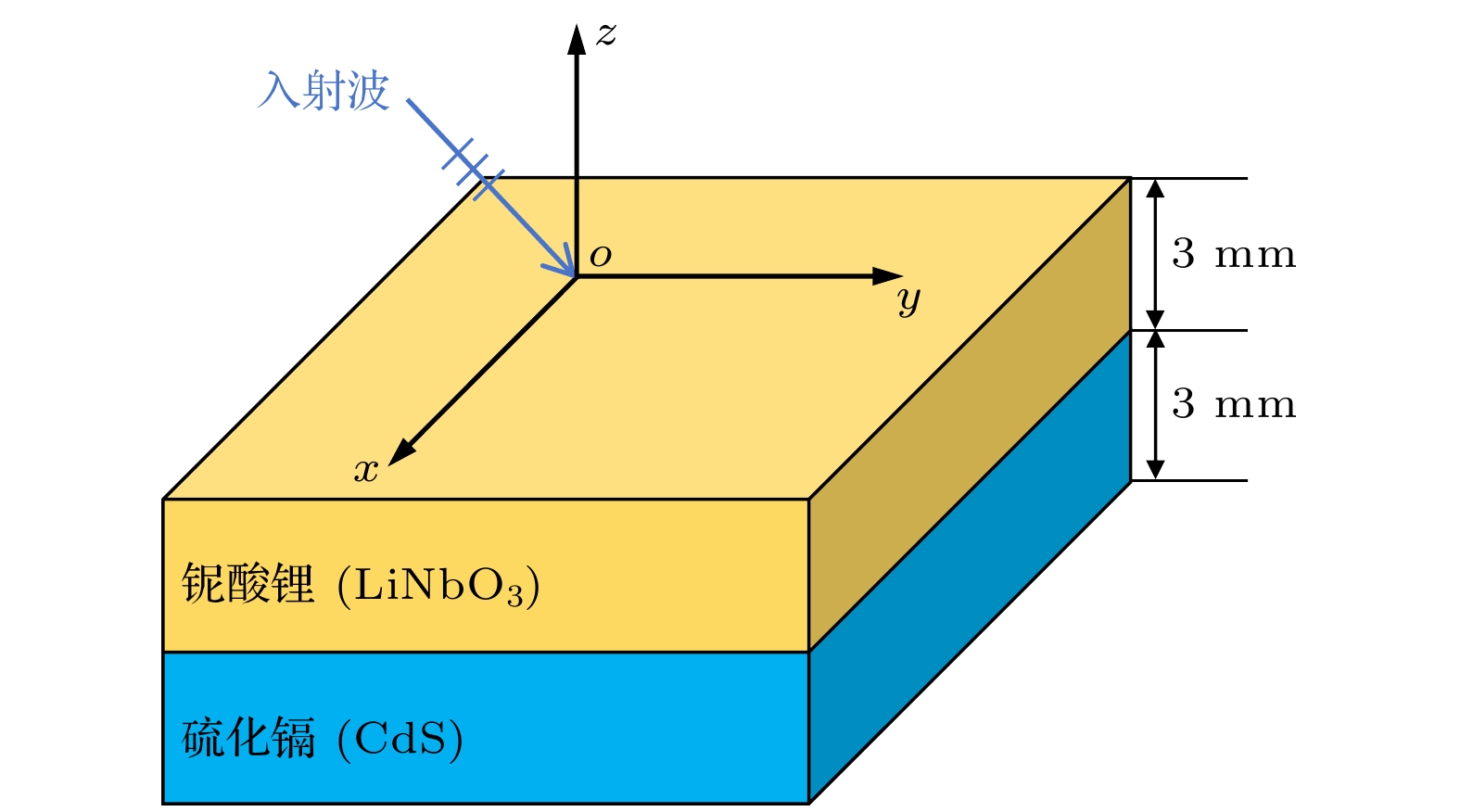-
提出了一种高效分析单轴/双轴双各向异性媒质电磁特性的快速传输矩阵法(rapid-transfer matrix method, R-TMM). 该方法基于旋度麦克斯韦方程, 构造了关于电场的齐次微分方程, 并通过复杂的矩阵运算, 导出用于特征值求解的布克四次方程. 随后, 从特征方程中提取单轴/双轴双各向异性媒质的特征值. 在此基础之上, 通过对层状结构中电磁场在分界面处切向连续性的深入研究, 构建了适用于多层媒质中平面波传播的传输矩阵. 结合上下行波在不同区域的传播关系, 推导出单轴/双轴双各向异性传播系数的计算公式. 最后, 设计了单轴/双轴双各向异性材料模型, 并对R-TMM和传统传输矩阵法(conventional-transfer matrix method, C-TMM)的计算结果进行了分析. 数值实验表明, R-TMM不仅能够精确计算单轴/双轴双各向异性媒质的传输系数, 而且可以实现计算效率的大幅度提升. 该方法为科研人员开展单轴/双各向异性媒质电磁特性的研究提供了可靠且高效的计算策略.
-
关键词:
- 单轴/双轴双各向异性 /
- 特征值 /
- 快速传输矩阵法
Uniaxial/biaxial bianisotropic materials are widespreadly used in manufacturing optical devices , owing to their distinctive electromagnetic response characteristics. To effectively analyze the electromagnetic properties of uniaxial/biaxial bianisotropic materials, rapid-transfer matrix method (R-TMM) to investigate the propagation process of plane waves in the media is proposed. Starting from the Maxwell’s equations in the time domain, a homogeneous differential equation about the electric field is constructed by processing the matrix containing dielectric and magnetic conductivity, electric and magnetic loss, tellegen and chirality carrier parameters, and the complex matrix operation is applied to that equation to obtain the Booker quartic equation, and then the formulae method is utilized to obtain the eigenvalues in the uniaxial/biaxial bianisotropic media. Subsequently, the tangential continuity of layered media at the interface is employed to establish a transfer matrix for single-layered media. In the case of multi-layered media, the transfer matrix of plane waves propagating in multi-layered uniaxial/biaxial bianisotropic media can be obtained by means of a continuous iteration process based on the transfer matrix of single-layered media. The formula for calculating the propagation coefficients of uniaxial/biaxial bianisotropic materials can be derived based on the different upward and downward waves in the reflection/transmission region. Finally, the reliability and efficiency of R-TMM are verified from two numerical experiments with the plane waves incident at different angles on uniaxial/biaxial bianisotropic media. The first experiment is designed as a single-layered biaxial bianisotropic model with more general electromagnetic parameters, and the second experiment is designed as a double-layered uniaxial and biaxial bianisotropic model consisting of common optical materials, which are composed of two non-magnetic materials, lithium niobate (LiNbO3) and cadmium sulfide (CdS). The experimental results demonstrate that compared with the conventional conventional-transfer matrix method (C-TMM), the R-TMM reduces the computational memory and CPU time required for calculating the reflection and transmission coefficients of the uniaxial/biaxial bianisotropic model by over 98%, while maintaining the accuracy of the reflection and transmission coefficient calculations. Therefore, R-TMM provides an efficient and dependable approach for the designing complex optical devices and analyzing uniaxial/biaxial bianisotropic propagation characteristics.[1] Chen Y X, Duan G Y, Xu C Y, Qin X F, Zhao Q, Zhou H Q, Wang B X 2024 Diam. Relat. Mater. 143 110939
 Google Scholar
Google Scholar
[2] Hosseini K, Atlasbaf Z 2018 IEEE Trans. Antennas Propag. 66 7483
 Google Scholar
Google Scholar
[3] Ahmed F, Hassan T, Shoaib N 2020 IEEE Antennas Wirel. Propag. Lett. 19 1833
 Google Scholar
Google Scholar
[4] Dong Z J, Feng X, Zhou H Q, Liu C, Zhang M H, Liang W J 2023 IEEE Trans. Geosci. Remote Sens. 61 4503120
 Google Scholar
Google Scholar
[5] Kong J A 1972 Proc. IEEE 60 1036
 Google Scholar
Google Scholar
[6] 王一平 2007 工程电动力学 (第二版) (西安: 西安电子科技大学出版社) 第23−24页
Wang Y P 2007 Engineering Electrodynamics (2rd Ed.) (Xi’ an: Xidian University Press) pp23–24
[7] Zarifi D, Soleimani M, Abdolali A 2014 IEEE Trans. Antennas Propag. 62 1538
 Google Scholar
Google Scholar
[8] Dimitriadis A I, Kantartzis N V, Tsiboukis T D 2013 IEEE Trans. Magn. 49 1769
 Google Scholar
Google Scholar
[9] Mousvai S M, Arand B A, Forooraghi K 2021 IEEE Access. 9 54241
 Google Scholar
Google Scholar
[10] Hasar U C, Ozturk G, Kaya Y, Barroso J J, Ertugrul M 2021 IEEE Trans. Antennas Propag. 69 7064
 Google Scholar
Google Scholar
[11] Karimi P, Rejaei B, Khavasi A 2023 IEEE Trans. Antennas Propag. 71 2507
 Google Scholar
Google Scholar
[12] 陈伟, 黄海, 杨利霞, 薄勇, 黄志祥 2023 72 060201
 Google Scholar
Google Scholar
Chen W, Huang H, Yang L X, Bo Y, Huang Z X 2023 Acta Phys. Sin. 72 060201
 Google Scholar
Google Scholar
[13] 谢国大, 侯桂林, 牛凯坤, 冯乃星, 方明, 李迎松, 黄志祥 2023 72 150201
 Google Scholar
Google Scholar
Xie G D, Hou G L, Niu K K, Feng N X, Fang M, Li Y S, Huang Z X 2023 Acta Phys. Sin. 72 150201
 Google Scholar
Google Scholar
[14] Demarest K 1987 IEEE Trans. Antennas Propag. 35 826
 Google Scholar
Google Scholar
[15] 葛德彪, 闫玉波 2005 电磁波时域有限差分方法 (第三版) (西安: 西安电子科技大学出版社) 第259—294页
Ge D B, Yan Y B 2005 Finite-Difference Time-Domain Method for Electromagnetic Waves (3rd Ed.) (Xi’an: Xidian University Press) pp259−294
[16] 王飞, 葛德彪, 魏兵 2009 58 6356
 Google Scholar
Google Scholar
Wang F, Ge D B, Wei B 2009 Acta Phys. Sin. 58 6356
 Google Scholar
Google Scholar
[17] Greenwood A D, Jin J M 1999 IEEE Trans. Antennas Propag. 47 1260
 Google Scholar
Google Scholar
[18] 孙宏祥, 许伯强, 王纪俊, 徐桂东, 徐晨光, 王峰 2009 58 6344
 Google Scholar
Google Scholar
Sun H X, Xu B Q, Wang J J, Xu G D, Xu C G, Wang F 2009 Acta Phys. Sin. 58 6344
 Google Scholar
Google Scholar
[19] Hanninen I, Nikoskinen K 2008 IEEE Trans. Antennas Propag. 56 278
 Google Scholar
Google Scholar
[20] 王哲, 王秉中 2014 63 120202
 Google Scholar
Google Scholar
Wang Z, Wang B Z 2014 Acta Phys. Sin. 63 120202
 Google Scholar
Google Scholar
[21] 葛德彪, 魏兵 2011 电磁波理论 (北京: 科学出版社) 第62—73页
Ge D B, Wei B 2011 Electromagnetic Waves Theory (Beijing: Science Press) pp62−73
[22] Johnston T W 1969 Radio Sci. 4 729
 Google Scholar
Google Scholar
[23] Chen H C 1981 Radio Sci. 16 1213
 Google Scholar
Google Scholar
[24] Tan E L, Tan S Y 1999 IEEE Trans. Antennas Propag. 47 1820
 Google Scholar
Google Scholar
[25] 郑宏兴, 葛德彪 2000 49 1702
 Google Scholar
Google Scholar
Zheng H X, Ge D B 2000 Acta Phys. Sin. 49 1702
 Google Scholar
Google Scholar
[26] Jiang Y Y, Shi H Y, Zhang Y Q, Hou C F, Sun X D 2007 Chin. Phys. 16 1959
 Google Scholar
Google Scholar
[27] Sarrafi P, Qian L 2012 IEEE J. Quantum Electron. 48 559
 Google Scholar
Google Scholar
[28] 王飞, 魏兵 2019 68 244101
 Google Scholar
Google Scholar
Wang F, Wei B 2019 Acta Phys. Sin. 68 244101
 Google Scholar
Google Scholar
[29] Zhang Y X, Feng N X, Wang G P, Zheng H X 2021 IEEE Trans. Antennas Propag. 69 4727
 Google Scholar
Google Scholar
-
表 1 单层双轴双各向异性的电磁参数
Table 1. Electromagnetic parameters of single-layered biaxial bianisotropic medium.
$\boldsymbol\varepsilon_{\rm r}$ $\boldsymbol \mu_{\rm r} $ $\boldsymbol \sigma_{\rm e} $ $\boldsymbol \sigma_{\rm m} $ $ \left[ {\begin{array}{*{20}{c}} {5.6}&0&0 \\ 0&{4.8}&0 \\ 0&0&{6.1} \end{array}} \right] $ $ \left[ {\begin{array}{*{20}{c}} {2.9}&0&0 \\ 0&{4.2}&0 \\ 0&0&{2.6} \end{array}} \right] $ $ \left[ {\begin{array}{*{20}{c}} {2.9}&0&0 \\ 0&{4.2}&0 \\ 0&0&{2.6} \end{array}} \right] $ $ \left[ {\begin{array}{*{20}{c}} {271}&0&0 \\ 0&{422}&0 \\ 0&0&{354} \end{array}} \right] $ $\boldsymbol \xi $ $\boldsymbol \zeta $ $ \left[ {\begin{array}{*{20}{c}} {3.9 + 0.01{\text{j}}}&0&0 \\ 0&{5.3 + 0.03{\text{j}}}&0 \\ 0&0&{4.3 + 0.06{\text{j}}} \end{array}} \right] $ $ \left[ {\begin{array}{*{20}{c}} {3.9 - 0.01{\text{j}}}&0&0 \\ 0&{5.3 - 0.03{\text{j}}}&0 \\ 0&0&{4.3 - 0.06{\text{j}}} \end{array}} \right] $ 表 2 C-TMM和R-TMM计算单层媒质传播系数的效率比较
Table 2. Comparison of efficiency between C-TMM and R-TMM in calculating the propagation coefficients of single-layered medium.
方法 CPU核数 内存/MB CPU时间/s
TE
TMC-TMM 1 729.4 9.2541 10.6075 R-TMM 1 5.3 0.1303 0.1521 比率 (R-TMM / C-TMM) 0.0073 0.01408 0.01434 表 3 两种光学材料的电磁参数
Table 3. Electromagnetic parameters of two optical materials.
Media $\boldsymbol\varepsilon_{\rm r}$ $\boldsymbol\mu_{\rm r}$ $\boldsymbol\sigma_{\rm r}$ $\boldsymbol\sigma_{\rm r}$ LiNbO3 $ \left[ {\begin{array}{*{20}{c}} {32.3}&0&0 \\ 0&{32.3}&0 \\ 0&0&{37.4} \end{array}} \right] $ $ \left[ {\begin{array}{*{20}{c}} {1.0}&0&0 \\ 0&{1.0}&0 \\ 0&0&{1.1} \end{array}} \right] $ $ \left[ {\begin{array}{*{20}{c}} {4.9}&0&0 \\ 0&{4.9}&0 \\ 0&0&{5.8} \end{array}} \right] $ $ \left[ {\begin{array}{*{20}{c}} {356}&0&0 \\ 0&{356}&0 \\ 0&0&{564} \end{array}} \right] $ CdS $ \left[ {\begin{array}{*{20}{c}} {6.25}&0&0 \\ 0&{6.01}&0 \\ 0&0&{6.32} \end{array}} \right] $ $ \left[ {\begin{array}{*{20}{c}} {1.0}&0&0 \\ 0&{1.0}&0 \\ 0&0&{1.0} \end{array}} \right] $ $ \left[ {\begin{array}{*{20}{c}} {0.02}&0&0 \\ 0&{0.03}&0 \\ 0&0&{0.01} \end{array}} \right] $ $ \left[ {\begin{array}{*{20}{c}} 0&0&0 \\ 0&0&0 \\ 0&0&0 \end{array}} \right] $ Media $\boldsymbol\xi $ $\boldsymbol\zeta $ LiNbO3 $ \left[ {\begin{array}{*{20}{c}} {0.02}&0&0 \\ 0&{0.02}&0 \\ 0&0&{0.01} \end{array}} \right] $ $ \left[ {\begin{array}{*{20}{c}} {0.02}&0&0 \\ 0&{0.02}&0 \\ 0&0&{0.01} \end{array}} \right] $ CdS $ \left[ {\begin{array}{*{20}{c}} {4.5 + 0.01{\text{j}}}&0&0 \\ 0&{6.6 + 0.02{\text{j}}}&0 \\ 0&0&{3.9 + 0.01{\text{j}}} \end{array}} \right] $ $ \left[ {\begin{array}{*{20}{c}} {4.5 - 0.01{\text{j}}}&0&0 \\ 0&{6.6 - 0.02{\text{j}}}&0 \\ 0&0&{3.9 - 0.01{\text{j}}} \end{array}} \right] $ 表 4 C-TMM和R-TMM在计算多层光学材料传播系数时的效率对比
Table 4. Comparison of efficiency between C-TMM and R-TMM in calculating the propagation coefficient of multilayer optical materials.
方法 CPU核数 内存/MB CPU时间/s TE TM C-TMM 1 744.2 11.8062 11.8935 R-TMM 1 7.6 0.1796 0.1851 比率 (R-TMM/C-TMM) 0.0102 0.0152 0.0156 -
[1] Chen Y X, Duan G Y, Xu C Y, Qin X F, Zhao Q, Zhou H Q, Wang B X 2024 Diam. Relat. Mater. 143 110939
 Google Scholar
Google Scholar
[2] Hosseini K, Atlasbaf Z 2018 IEEE Trans. Antennas Propag. 66 7483
 Google Scholar
Google Scholar
[3] Ahmed F, Hassan T, Shoaib N 2020 IEEE Antennas Wirel. Propag. Lett. 19 1833
 Google Scholar
Google Scholar
[4] Dong Z J, Feng X, Zhou H Q, Liu C, Zhang M H, Liang W J 2023 IEEE Trans. Geosci. Remote Sens. 61 4503120
 Google Scholar
Google Scholar
[5] Kong J A 1972 Proc. IEEE 60 1036
 Google Scholar
Google Scholar
[6] 王一平 2007 工程电动力学 (第二版) (西安: 西安电子科技大学出版社) 第23−24页
Wang Y P 2007 Engineering Electrodynamics (2rd Ed.) (Xi’ an: Xidian University Press) pp23–24
[7] Zarifi D, Soleimani M, Abdolali A 2014 IEEE Trans. Antennas Propag. 62 1538
 Google Scholar
Google Scholar
[8] Dimitriadis A I, Kantartzis N V, Tsiboukis T D 2013 IEEE Trans. Magn. 49 1769
 Google Scholar
Google Scholar
[9] Mousvai S M, Arand B A, Forooraghi K 2021 IEEE Access. 9 54241
 Google Scholar
Google Scholar
[10] Hasar U C, Ozturk G, Kaya Y, Barroso J J, Ertugrul M 2021 IEEE Trans. Antennas Propag. 69 7064
 Google Scholar
Google Scholar
[11] Karimi P, Rejaei B, Khavasi A 2023 IEEE Trans. Antennas Propag. 71 2507
 Google Scholar
Google Scholar
[12] 陈伟, 黄海, 杨利霞, 薄勇, 黄志祥 2023 72 060201
 Google Scholar
Google Scholar
Chen W, Huang H, Yang L X, Bo Y, Huang Z X 2023 Acta Phys. Sin. 72 060201
 Google Scholar
Google Scholar
[13] 谢国大, 侯桂林, 牛凯坤, 冯乃星, 方明, 李迎松, 黄志祥 2023 72 150201
 Google Scholar
Google Scholar
Xie G D, Hou G L, Niu K K, Feng N X, Fang M, Li Y S, Huang Z X 2023 Acta Phys. Sin. 72 150201
 Google Scholar
Google Scholar
[14] Demarest K 1987 IEEE Trans. Antennas Propag. 35 826
 Google Scholar
Google Scholar
[15] 葛德彪, 闫玉波 2005 电磁波时域有限差分方法 (第三版) (西安: 西安电子科技大学出版社) 第259—294页
Ge D B, Yan Y B 2005 Finite-Difference Time-Domain Method for Electromagnetic Waves (3rd Ed.) (Xi’an: Xidian University Press) pp259−294
[16] 王飞, 葛德彪, 魏兵 2009 58 6356
 Google Scholar
Google Scholar
Wang F, Ge D B, Wei B 2009 Acta Phys. Sin. 58 6356
 Google Scholar
Google Scholar
[17] Greenwood A D, Jin J M 1999 IEEE Trans. Antennas Propag. 47 1260
 Google Scholar
Google Scholar
[18] 孙宏祥, 许伯强, 王纪俊, 徐桂东, 徐晨光, 王峰 2009 58 6344
 Google Scholar
Google Scholar
Sun H X, Xu B Q, Wang J J, Xu G D, Xu C G, Wang F 2009 Acta Phys. Sin. 58 6344
 Google Scholar
Google Scholar
[19] Hanninen I, Nikoskinen K 2008 IEEE Trans. Antennas Propag. 56 278
 Google Scholar
Google Scholar
[20] 王哲, 王秉中 2014 63 120202
 Google Scholar
Google Scholar
Wang Z, Wang B Z 2014 Acta Phys. Sin. 63 120202
 Google Scholar
Google Scholar
[21] 葛德彪, 魏兵 2011 电磁波理论 (北京: 科学出版社) 第62—73页
Ge D B, Wei B 2011 Electromagnetic Waves Theory (Beijing: Science Press) pp62−73
[22] Johnston T W 1969 Radio Sci. 4 729
 Google Scholar
Google Scholar
[23] Chen H C 1981 Radio Sci. 16 1213
 Google Scholar
Google Scholar
[24] Tan E L, Tan S Y 1999 IEEE Trans. Antennas Propag. 47 1820
 Google Scholar
Google Scholar
[25] 郑宏兴, 葛德彪 2000 49 1702
 Google Scholar
Google Scholar
Zheng H X, Ge D B 2000 Acta Phys. Sin. 49 1702
 Google Scholar
Google Scholar
[26] Jiang Y Y, Shi H Y, Zhang Y Q, Hou C F, Sun X D 2007 Chin. Phys. 16 1959
 Google Scholar
Google Scholar
[27] Sarrafi P, Qian L 2012 IEEE J. Quantum Electron. 48 559
 Google Scholar
Google Scholar
[28] 王飞, 魏兵 2019 68 244101
 Google Scholar
Google Scholar
Wang F, Wei B 2019 Acta Phys. Sin. 68 244101
 Google Scholar
Google Scholar
[29] Zhang Y X, Feng N X, Wang G P, Zheng H X 2021 IEEE Trans. Antennas Propag. 69 4727
 Google Scholar
Google Scholar
计量
- 文章访问数: 3861
- PDF下载量: 132
- 被引次数: 0














 下载:
下载:







